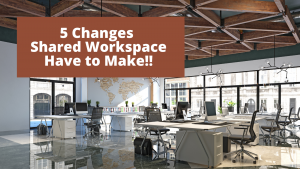
Hey, Shared Workspace owners and managers….are you ready for the return of businesses needing private office space?
In case you are not, here are five changes you need to make right away before they get here.
1. Noise
You better get ready to deal with more noise than you have ever had. These business people have been penned up for over a year. Many are not happy to have to return to work from an office. Many are overly excited. All of them have had to make huge changes in how socialize and how they do their work.
As a result, all of them are going to want to TALK to others…sometimes that other person could be on the other side of the building. The keyword here is TALK and with talk comes noise.
Another habit these people have developed..or had before they left and have just honed the habit to being something they feel is normal… is using their smartphone speakerphone.
When they were working at home they would take their phone off vibrate and turn up the volume on their ringtone…just in case they are in the shower when their boss calls for a status report they can answer the call. When they do answer it would be on the speakerphone so they could go ahead and finish what they were doing…which 99% of the time is not work-related…while talking on the phone.
All this noise and more is heading to the shared workspace their business has secured private office space.
The noise level is going to be so intense that eventually one of the business owners…probably the ones who never left the shared workspace… will say something to the management or owners of the shared workspace. And what they might say is…we are out of here if you can’t get the noise under control.
High levels of noise have always been one of the major downsides of shared workspace facilities, especially the facilities that took the cheap way out and did not build in sound buffers like flooring; recessed glass walls and doors of offices; ceiling sound curtains; and sound absorbents on the walls.
Plus not having a noise policy doesn’t help the owners to manage the situation.
2. Pets
One of the many things office workers had to deal with while being sequestered at home during the COVID-19 pandemic was taking care of their pets. Many got a pet during this time just to have someone there with them. Nothing wrong with having a pet…at home.
Well, guess what…many of them are going to want to bring their pet to work with them. Are you ready for that? Probably not.
How will the other tenants of the shared workspace react? Answer: Not well.
Yes, animals…particularly dogs and cats…are cute. But, not everyone feels having an animal in the workspace condones a professional atmosphere that their consumer will accept.
Having a dog or cat roaming the building is OK if you OWN the building. However, in a shared workspace it is just that…shared. And most of the businesses sharing the building’s space are there to meet with clients who are going to not think favorably of the business when a dog or cat (or potbelly pig) enters your meeting.
Shared workspace owners may need to check with the attorney before allowing their members, tenants, leasees, or whatever they are called in their terms of agreements, to bring in their pets.
The bottomline: Shared workspace owners should find out what their current tenant’s feelings are on pets being allowed in the shared workspace and NOT wait till one of the returning members walks in with their pet Imu.
3. Code of Conduct
One of the issues growing just before everyone in the business world was mandated to stay home to ride out the COVID-19 pandemic, was how people from different businesses socialized with each other in shared workspace facilities.
Most of the owners and managers of shared workspace did not deal with the tensions building between their tenants whose personalities clash or social mannerisms just rub each other raw.
Simple things like one business holding a meeting in their office using the speakerphone turned up full blast disturbing the other surrounding businesses. Or a business holding their happy hour at 10AM outside another business’ office that needs quiet to get their work done.
Having a code of conduct would give both the owner and tenant a list of expectations they agree to before signing their lease.
4. Business Operation Benefits
Many of the businesses that left the shared workspace environment have had to make changes to how they do business.
One of the subtle things most businesses were forced to make was in their Trust of others to keep them and their employees safe.
Trusting the owners to take their needs to keep their employees safe and healthy is something they take very seriously. The trust will only come when the owners and managers of shared workspace facilities demonstrate their dedication to keeping their tenants safe. This demonstration would be much more than posting a few signs.
Requiring every returning tenant to sign off on new terms of the agreement that include tenant behavior clauses will be needed.
One of the major changes shared workspace owners will need to address is how to differentiate what they offer businesses from the shared workspace across the street.
Businesses returning to the shared workspace environment are going to not be interested in the bullpen-style workspace. To keep themself and their employees safe and healthy they are going to only want private offices with doors they can close.
Adding benefits to the lease, like lunches, video marketing and exclusive happy hours are what businesses…large and small…are looking for if they are going to return to shared workspaces. Otherwise, these businesses are going to go to facilities that do offer them more value to their operations.
5. Lower Cost
The most obvious change for the owners of the shared workspace industry is to lower their lease pricing which would require them to go back to the traditional price by the square foot need instead of how many desks or people can they crowd into a specific space.
Not only will the returning business not tolerate tactics seen as herding a lot of people into small spaces but they also are going to shop pricing by the amount of space they will need to keep their employees safe.
The changes in the shared workspace industry is going to require them to take a step back and change their thinking…and probably their business plan. The “take it or leave it” attitude that many of the shared workspaces have developed will backfire on them. Especially in the markets where there is a large amount of open office space available.
Stay Concerned
The pandemic and the mandated stay-at-home requirements is still here and could come back. If it does shared workspaces that do not change to the current demands are probably not going to make it this time around.
Yes, all of this is my opinion, but all back on my actual 7 years of experience running my businesses from several shared workspaces, which means…I have been talking to a lot of my co-tenants and I listen to what they all have to say.











